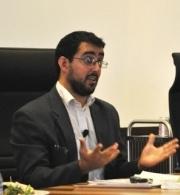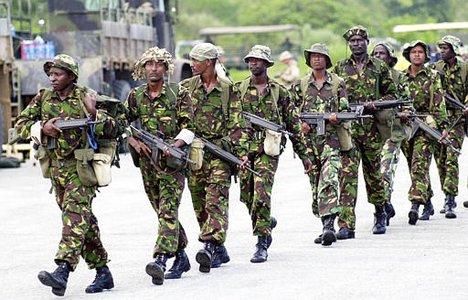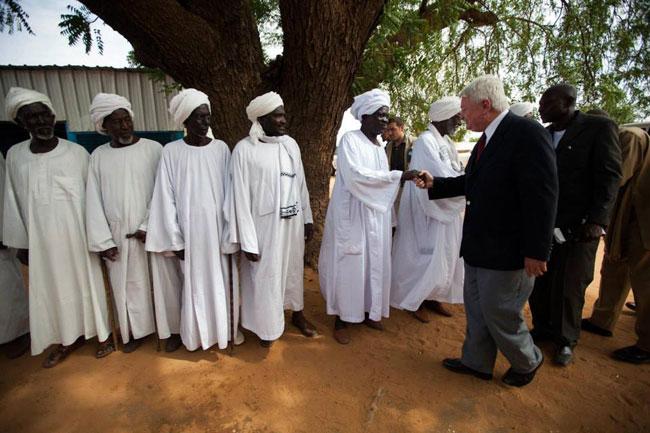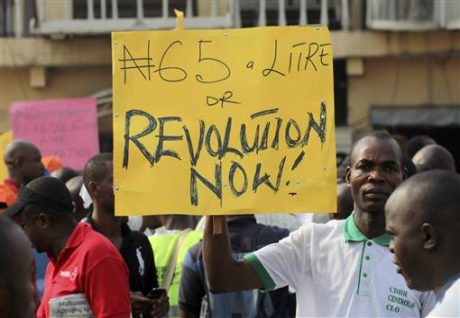ALY VERJEE – An argument against arming the South: ‘More arms in Sudan serves no ordinary Sudanese’

 In recent commentary, some in the advocacy community have suggested that the United States actively move to provide the new Republic of South Sudan with anti-aircraft weapons system technology, including “medium-range surface-to-air missile systems.”
In recent commentary, some in the advocacy community have suggested that the United States actively move to provide the new Republic of South Sudan with anti-aircraft weapons system technology, including “medium-range surface-to-air missile systems.”
There is some irony in anti-conflict advocates finding common cause with arms manufacturers and vendors, those who would benefit most from the export of sophisticated arms systems. In the Enough Project’s endorsement of Congressman Don Payne’s proposal to provide such technology to South Sudan, David Sullivan says that this is “the less bad option.” John Bradshaw, Enough’s Executive Director, notes that such systems should be “closely monitored to ensure they are used for protection of civilian populations…this equipment and training should provide leverage to improve the human rights record of the southern security forces.”
I don’t doubt the good intentions of the folks at Enough. But this is simply a bad idea. A Cold War era policy of deterrence belongs precisely there – in the annals of history. The last thing East Africa needs is more weaponry, high tech or otherwise. The United States should not contribute to an arms race between North and South Sudan – the two future states are well on their way to achieving that already. Instead, the US should remain an honest broker and encourage both North and South to choose the path of responsible statehood, without further contributing to already tense relations. This is a less sexy policy than giving the South fancy weapon systems, to be sure. But it is a policy of pragmatism that de-escalates rather than antagonizes.
The arguments put forth by both Sullivan and Bradshaw do not stand up. Allowing the export of these weapons adds little if nothing to the already significant leverage the US holds over the South’s army, the SPLA. Providing weapons on the cheap – for South Sudan would hardly be expected to pay full price – merely frees up resources for the SPLA to use on other military acquisitions. Suggesting that new arms systems could somehow link to improving the SPLA’s human rights record is laughable – security sector reform just doesn’t work that way. Further, there is no “vetting” in the world that could ensure that only “responsible” units have access to such systems, even if the SPLA eliminates its chronic problem of ill-disciplined troops. As has been shown time and time again across the world, once arms are exported, there is no feasible way the original provider can maintain control, no matter the end use certification in place. Arms export is not a reversible process.
Sullivan is right that the South “will use the benefits of sovereignty to expand [its] arsenal.” But it is naive to think that “the alternative to U.S. support is likely to involve much cheaper and more easily trafficked weapons including man-portable air defense systems…[t]his would have all of the alarming negative consequences and none of the supervision that a more responsible U.S.-assisted program would entail.” US support for air defence technology will not prevent, nor change, the South’s pursuit of more easily trafficked weapons.
The South’s ambition to build a more formidable army with offensive capabilities – as witnessed in recent tank and helicopter procurements – may only grow post-independence. Condition-free arms acquisition is certainly desirable for the SPLA; the idea that additional US assistance in arms procurement could somehow dissuade that objective from being pursued is false. There are just too many options for “˜no questions asked’ arms purchases. The army’s peace dividend, paradoxically, is more tools to fight wars; that is why US efforts should be focused on professionalizing the SPLA’s troops and improving their planning and management capacities.
Rather than worrying about the “development of rigorous systems to distinguish U.N. flights from military bombers”, we should worry about the implications of encouraging an arms race in such a combustible region. North Sudan continues to import arms in violation of UN sanctions. Giving the North further licence to upgrade its capacities will not serve civilians on either side of the border. The greatest future threat to the South from the North will not come from the air. There is plenty on the ground the North can do to destabilize the new Republic of South Sudan, whether through supporting rebel militia groups or proxy forces, allowing small arms to proliferate, or disrupting trade across the border.
Preventing Khartoum from choosing to return to such tactics is a critical strategic priority. But if Khartoum did in future wage full-scale war against the South, it would be, as Abyei and Southern Kordofan have demonstrated, primarily a ground offensive, notwithstanding the headline reporting of such attacks, which focus on aerial bombing. Air defence technology would be in any case an impotent deterrent.
But let us consider the possibility of air strikes against the South. Khartoum has certainly not been shy to use its air power against civilians – in the south during the civil war, in the ongoing war in Darfur, and most recently in Abyei and Southern Kordofan. A quirk of international law is that there are fewer consequences in terrorizing your own citizens than attacking those of a sovereign state.
Post-July 9, any air attack on South Sudan would be an act of war. There would be no question of interference in the affairs of a sovereign state. Khartoum would have to reckon with the consequences of international rather than domestic aggression, and, much like its decision to support Iraq against Kuwait in the first Gulf War, the likely prospect of a return to pariahdom, an outcome that could potentially be the begining of the end for the regime itself. China and Russia may appear to be stalwart allies of Khartoum, but they have growing interests in the South. If a sovereign South Sudan is the victim of aggression, Khartoum cannot expect unconditional support from its traditional friends.
Arming the South might seem to be the right thing to do. But this is a short sighted policy. Worse, it would play into the hands of that same Khartoum military-industrial complex responsible for so much violence. More arms in Sudan serves no ordinary Sudanese.







Groovy dance around the ten-tonne elephant, resplendent with fuchsia lipstick, in the room, Aly!!
Has ‘rump Sudan’ ever threatened ONCE to invade or menace south Sudan proper (not Abyei – which is quite distinct) since the signing of the CPA??
“Noâ€.
So, why, then, the red herring discussion of providing the soon-to-be Republic of South Sudan (ROSS) with such a deterrent – i.e.: “Preventing Khartoum from choosing to return to such tactics is a critical strategic priority�??
Based on precisely what, Mr. Verjee??
You mean the activist pap and bending of the narrative about the recent upheavals in Southern Kordofan and Abyei, which, like the activists, you have provided absolutely no contextualisation for???
In that regard, it’s totally amazing that you have chosen to ignore the key role of SPLM/A or “southern forces†in sparking the turmoil in Abyei and South Kordofan and, in turn, like the activists again, have de facto portrayed the conflict in those two places as just two more typical examples of leftfield, brutish behaviour by a racist and Arab supremacist Sudan Armed Forces (SAF), bearing down yet again on a completely innocent and whiter-than-white non-Arab group – this time the Nuba and, earlier, the Ngok Dinka.
Your arguments for providing a deterrent against ‘Khartoum’ attacking the future ROSS remind one very much of the same phantom justifications peddled internationally by successive Israeli government in possessing nukes to deter neighbouring Arab countries – over which Israel evidently already has massive military advantages in conventional terms and, in turn, pose no real existential threat to Israel – only a ‘virtual’ one.
No, to be clear: the biggest idiocies of Rep Donald Payne’s suggestion to provide the Government of South Sudan (GOSS) with air defence systems – quelle une surprise, endorsed eagerly by John, “JPâ€, Prendergast) and others at Enough! – are twofold:
1) Fresh, shiny, military toys from Uncle Sam to Juba hardly rubs along nicely with the main part of the CPA, which has been neglected thus far by Sudanese actors and the international community alike – and is even MORE important now as south Sudan heads for separation:
Social reconciliation within and between ‘rump Sudan’ and ROSS.
How urgent is that??
Go figure: Sudan = site of Africa’s longest-ever civil war.
2) The real danger that the SPLA will use them on women, children, and other ordinary civilians in the soon-to-be Republic of South Sudan (ROSS). As you and other readers of this blog may be aware, the Government of South Sudan (GOSS) is being engulfed by no less than seven, intra-southerner, armed rebel movements, with the SPLA currently engaged in battles with those forces in six out of ten of the states that will make up ROSS.
The SPLA – hardly renowned for professional command and control, which, in turn, begs the unasked question by activists like JP and Mr. Bradshaw as to why GOSS’s leadership sends them in the first place to ‘quell’ those rebellions??? – is very likely to turn any air defence system on to the ‘inside’; in others words, not against ‘Khartoum’, but shelling ordinary civilians indiscriminately belonging to the same tribes as the southern rebel groups.
In case readers of this blog remain blissfully unaware, the SPLA has been going wild (REALLY wild) on women, children and other ordinary civilians in its attempts (facile so far) to crush the armed rebellions against GOSS’s rule; kindly see these two AP reports for further detail:
http://www.google.com/hostednews/ap/article/ALeqM5iGjG9whhCv3fK2pUQK5m9HkvOFig?docId=8760bf3cf28f4230838f7a530d928a4e
http://news.yahoo.com/s/ap/20110311/ap_on_re_af/af_southern_sudan_un_troops_2
And this happened earlier, too:
http://english.aljazeera.net/video/africa/2010/12/201012237023933452.html
Beyond horrific, aren’t they?
Given the above, do you, Mr. Verjee, or anybody else, still trust these guys (GOSS and its SPLA) to make sure that any new, shiny military toys from Father Christmas (the United States Gov) get used responsibly???
Precisely.
In the same way that USA does not always = Caucasians vs. African-Americans, Sudan does not always = Khartoum vs. Juba or, indeed, the other way round.
That’s worth remembering, Mr. Verjee.
All the time.
Moreover, who’s going to REALLY check to see that ‘end-user’ agreements for any mil hardware from the US is being put to use for the purpose intended by GOSS in say, swampy Jonglei State and other areas in future ROSS that remain off the world’s gaze???
Nobody.
Sincerely,
I Adam
El Fasher
Sudan
[…] Here is an argument against arming South Sudan: In recent commentary, some in the advocacy community have suggested that the United States actively move to provide the new Republic of South Sudan with anti-aircraft weapons system technology, including “medium-range surface-to-air missile systems.†Tweet […]
[…] Here is an argument against arming South Sudan: In recent commentary, some in the advocacy community have suggested that the United States actively move to provide the new Republic of South Sudan with anti-aircraft weapons system technology, including “medium-range surface-to-air missile systems.†[…]
Excellent commentary dispelling the arguments for what would be an absurdly stupid move by the US that would only escalate things further.
Secondly a good reminder (for those like Enough who get tempted to fall into Good vs Bad narratives to build support in an otherwise disinterested US) that the SPLA are no angels themselves (angels aren’t that common in wars) and also there is very little likelihood that these arms would not be diverted into the wrong hands. On both of these counts (and on the count of regional stability, among others), properly working export control laws in the US would not allow such a transfer… unfortunately politics could trump the day, as per usual.
I wonder whether Mr I Adam actually read the article or was simply being reactive?
Dear CKI:
Did I “actually read the article”?
Mais bien sur – and I broadly agree, too, with Mr. Verjee’s sentiments – save for this sentence:
“Preventing Khartoum from choosing to return to such tactics is a critical strategic priorityâ€.
That got my goat ‘cos it’s straight out of ‘Virtual Sudan-ville’.
It is also emblematic of the activist – not saying that Mr. Verjee is one – approach to Sudan; i.e. construct a ‘non-story’ by presenting as fact an outlandish opinion that lacks a shred of ACTUAL evidence in the REAL Sudan and, thereafter ‘layering’ it – even though the foundation is suspect to say the least, in this case:
“Preventing Khartoum from choosing to return to such tactics is a critical strategic priority.”
Indeed, as put to Mr. Verjee, precisely what FACTS underpin said “critical strategic priority”?
That’s an entirely reasonable question to ask, CKI (wasn’t being “reactive”).
Why?
As also said, it’s the type of rigid view of ‘Khartoum’ that makes social reconciliation throughout and in Sudan, and between and within the soon-to-be ROSS, difficult.
Very difficult.
Sincerely,
IAdam
Sudan
I agree with Mr. Verjee’s argument that the United States can most benefit South Sudan in the long-term by helping to professionalize and de-factionalize its armed forces. Until the South Sudanese officer corps develops a single, national identity, and answers exclusively to duly-elected civilian leaders, the army will be as much a liability as it is a resource. Likewise, until the army understands how best to employ the modern weaponry that it has been amassing since the CPA, its effectiveness will be severely impeded.
I also agree with Mr. Verjee’s criticism of the arguments made by Sullivan and Bradshaw. It is difficult to draw any plausible link between the mere introduction of new weapons systems and a reduction in either factionalization or human rights abuses. It is also questionable whether South Sudan could operate new equipment effectively without the direct involvement of external “advisers,” which has been the preferred method of North Sudan, as well as neighbors Ethiopia and Eritrea.
I disagree, however, with any suggestion that arming South Sudan would be a needlessly provocative or necessarily irresponsible approach from the point of view of its relationship with North Sudan. Khartoum’s recent decision to attack Abyei and South Kordofan clearly reflected an expectation that the SPLA was either unwilling or unable to post effective resistance. As Mr. Verjee himself has pointed out, the North is already in enthusiastic violation of the international arms embargo: it needs no invitation from South Sudan to spend its oil money on whatever cut-outs can obtain from the stockpiles of former Soviet states.
There are many good reasons to think twice about the order in which South Sudan is provided with the various components of national security. All of these relate to potential internal problems, however. Indeed, the only compelling reasons to ignore the SPLA’s long history of fractionalization arise when one takes a wider view that encompasses South Sudan’s neighbor to the north.